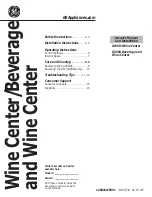
Step 5
Attach drain line to drain line fi tting. To prevent back pressure from reducing fl ow rate below minimum
required for backwash, drain line must be sized according to run length and relative height. Be careful not to
bend fl exible drain tubing sharply enough to cause "kinking" (if kinking occurs drain line must be replaced).
Typical examples of proper drain line diameters are:
(1) 1/2 in. ID up to 15 ft. when discharge is lower than inlet.
(2) 5/8 in. ID up to 15 ft. when discharge is slightly higher than inlet.
(3) 3/4 in. ID when drain is 25 ft. away and/or drain is installed overhead.
Some areas prohibit the use of fl exible drain lines. Check with local code offi cials prior to installation.
Step 6
Position drain line over drain and secure fi rmly. To prevent backsiphoning of waste water, provide an air gap
of at least 2 in. or 2 pipe diameters between end of drain hose and drain (Figure 3). DO NOT raise drain line
more than 10 ft. above fl oor.
Step 7
Connect one end of the 3/8 in. poly line to brine valve located on the right side of control valve. Connect other end to elbow inside of brine well. Brass insert
sleeves and plastic ferrules must be used where necessary. (Figure 2 and Control Valve Parts drawing, Section 7).
Step 8
Install overfl ow line to brine tank overfl ow fi tting (Figure 2). Discharge of line must be lower than overfl ow fi tting. DO NOT INTERCONNECT OVERFLOW LINE
WITH VALVE DRAIN LINE.
Step 9
Make certain bypass valve inlet and outlet knobs are in "BYPASS" position. After all plumbing connections have been completed, open main water shut-off valve
or restore power to well pump. Check for leaks and correct as necessary.
Step 10
Plug control valve power cord into 110v/60hz, non-switched power source. Manually
stage control to backwash position (See "How To Manually Regenerate Your Water Soft-
ener At Any Time") and then unplug power cord to prevent the unit from advancing
automatically.
Step 11
Partially open inlet valve in plumbing or on bypass valve (Figure 4). This will allow the
unit to fi ll slowly from the bottom up, eliminating air entrapment. Allow unit to fi ll slowly,
failure to do so could result in loss of resin to the drain. Once a steady stream of water,
no air, is fl owing to drain, the inlet valve can be fully opened. The outlet valve can also
be opened and the bypass (if applicable) can be closed.
Step 12
On time clock initiated models, set regeneration frequency. Refer to Regeneration Frequency Schedules (Section 3) to determine correct frequency, then refer to
How To Set Time Clock Regeneration Control (Section 3) for instructions on setting frequency. For meter initiated models, refer to How To Set Meter Regeneration
Control.
NOTE: Regeneration settings for both time clock and meter initiated models are factory preset for the most effi cient salt use and minimum water consumption
used for regeneration (as little as 30 gallons), and conform to the industry salt effi ciency standards (required by some states). Regeneration frequency schedules
are designed for use with factory regeneration settings (listed in Specifi cations And Operating Data, Section 6).
The control valve design permits adjustment of the salt dosage. This adjustment may be necessary when unusual operating conditions exist, such as high con-
centrations of iron or hardness and/or high fl ow rates or daily water consumption (refer to "How To Set Regeneration Cycle Program" Section 3) for adjustment
procedures.
NOTE: For salt dosages greater than 15 lbs (6.8 kg), grid leg extensions must be attached to bottom of grid legs. For salt dosages less than 15 lbs (6.8 kg). DO
NOT use extension legs.
2-3
SERVICE
BYPASS
ROTATE
KNOBS
Figure 4. Bypass Valve
EQUIPMENT
DRAIN LINE
DRAIN
2" REF.
AIR GAP
Figure 3. Typical Drain








































